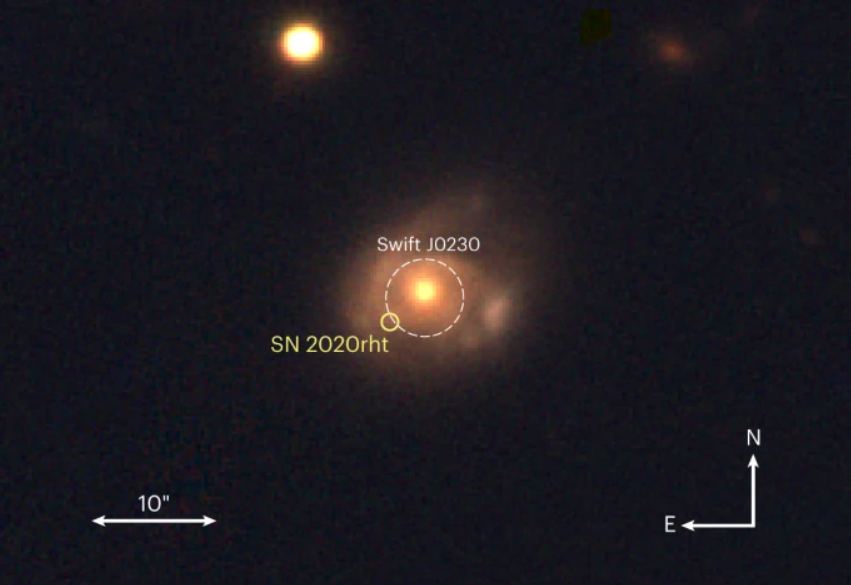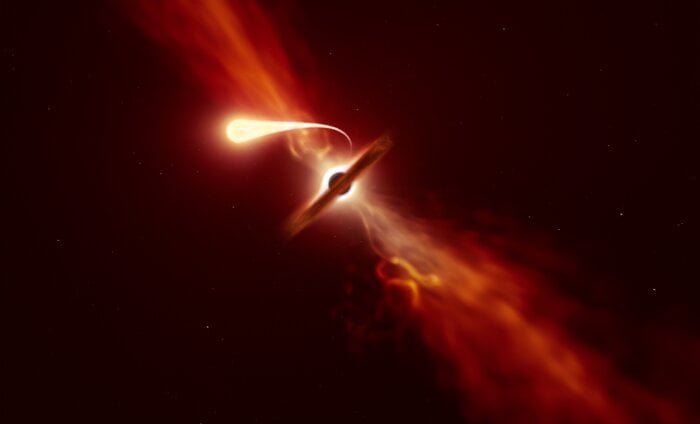Astronomers working with NASA's Neil Gehrels Swift Observatory have spotted something unusual. The observatory's X-Ray Telescope (XRT) has captured emissions from a supermassive black hole (SMBH) in a galaxy about 500 million light-years away. The black hole is repeatedly feeding on an unfortunate star that came too close.
When an SMBH feeds on a star, it's called a Tidal Disruption Event (TDE.) TDEs happen when a star comes too close to an SMBH, and the powerful gravity pulls material away from the star. The material is sucked into the swirling accretion disk outside the black hole, is heated, and emits radiation, especially x-rays. Sometimes, the star is destroyed. The black hole's overwhelming gravity literally pulls the star apart into a stream of gas. Sometimes, it survives, but never for long.
And sometimes, the black hole repeatedly feeds on the star. This can happen when a star follows a highly eccentric orbit. During its pericenter passage, it strays too close to the black hole. The star bulges toward the hole and surrenders some of its gas. When that happens, astronomers call it a repeating tidal disruption, or partial tidal disruption. Eventually, the star will lose enough mass and won't be able to hold itself together. It's mass against mass, and a supermassive black hole will always win. Astronomers are interested in the repeating TDE phenomenon and are studying it more closely.
The radiation created by all of this activity can tell astronomers about the characteristics of the black hole and the star. Every time the black hole adds more stellar material to its accretion disk, it releases energy. The type and amount of energy across different wavelengths reveals a lot about both the star and the black hole.
This newly discovered repeating TDE is called Swift J0230 (Swift J023017.0+283603.) It's half a billion light-years away in the constellation Triangulum. It appears to be taking a bite out of the doomed star every 25 days, though that can vary by a few days. Each brightening event lasts about 10 to 15 days, but the longest was about 20 days, and the shortest one was less than a day long.
A new paper presents this discovery. It's titled " Monthly quasi-periodic eruptions from repeated stellar disruption by a massive black hole," and it's published in Nature Astronomy. The lead author is Phil Evans, an astrophysicist at the University of Leicester and a longtime Swift team member.
The Swift Observatory was built to detect and study gamma-ray bursts (GRBs.) GRBs are stupendously energetic explosions observed in other galaxies. Swift has been very effective and observed its 1000th GRB in 2015. It's also detected four GRBs in a single day. The observatory has an X-ray telescope that can help locate a GRB more accurately and also monitor the explosion's afterglow. But it's also meant to quickly observe any transient X-ray phenomena, including TDEs.
In June 2022, it spotted Swift J0230 for the first time. According to Evans and his colleagues, a star similar to our Sun is orbiting an SMBH with more than 200,000 solar masses. Each time the black hole snacks on the star, it absorbs about three Earth masses of gas.
Swift J0230 takes a bite out of the orbiting star about every 25 days. But other known repeating TDEs have different frequencies. One well-known example has a 114-day frequency, and another has a short, nine-hour gap between events.
There are two types of known objects that are closely related to Swift J0230's emissions. One is a Quasi-Periodic Eruption (QPE), and the other is a Periodic Nuclear Transient (PNT.)
Astronomers think that QPEs are white dwarfs interacting with low-mass central black holes. PNTs are much longer outbursts in both duration and recurrence period, and astronomers think they're from main-sequence stars interacting with a black hole and emitting significant optical light. But Swift J0230 bridges the gap between the two. It's likely a main sequence star orbiting a modest-mass black hole. The discovery gives astronomers a chance to examine how different types of stars interact with black holes with different masses.
J0230 wasn't easy to spot. The astronomers found it with a new data-handling technique involving an automated search that Evans developed. It's called the Swift X-ray Transient Detector.
Each time the Swift Observatory monitors a section of the sky, it downloads the data. Then the Swift X-ray Transient Detector processes the data and compares it to previous Swift X-ray observations of the same region looking for changes. If the Transient Detector finds a change in the X-rays from the same region of the sky, it issues an alert, and astronomers can quickly coordinate follow-up observations.
Evans' new data processing system paid dividends almost immediately.
"Swift J0230 was discovered only about two months after Phil launched his program," said S. Bradley Cenko, Swift's principal investigator at NASA's Goddard Space Flight Center. "It bodes well for the detector's ability to identify other transient events and for Swift's future exploring new spaces of science."
"That this event was found within three?months of enabling this real-time search suggests that they are reasonably common..."From "Monthly quasi-periodic eruptions from repeated stellar disruption by a massive black hole."
Data analysis is a vital part of modern astronomy. It plays a huge role in upcoming observatories like the Vera Rubin Observatory. It can also give new life to older telescopes like the Swift Observatory. Swift was launched in 2004, and there's no way to update its hardware. But by leveraging advances in data analysis, astronomers are extracting new observations from its data. Without Evans' new data technique, Swift would never have detected Swift J0230.
"Swift's hardware, software, and the skills of its international team have enabled it to adapt to new areas of astrophysics over its lifetime," said lead author Evans.
Systems like Swift J0230 are difficult to discover. They have modest fluxes and no emissions outside the X-ray band. They require repeated observations to discover, unlike QPEs, which can be found in archival data. Real-time detectors like Evans' system are necessary since they can trigger rapid follow-up observations.
Hopefully, the system will find even more objects like Swift J0230.
"That this event was found within three?months of enabling this real-time search suggests that they are reasonably common, and we can expect to discover more objects of this class with sensitive, wide-field X-ray instruments such as eRosita and, in the near future, the Einstein Probe."
 Universe Today
Universe Today


